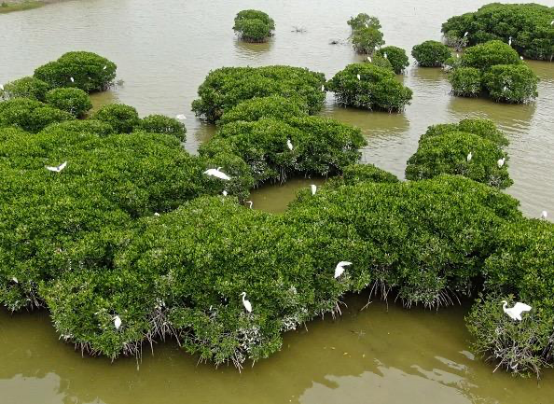The team led by Academician Yang Zhifeng at the Southern Marine Science and Engineering Guangdong Laboratory (Guangzhou) has made progress in mangrove restoration in China. Their findings, titled "Mangrove restoration in China’s tidal ecosystems," were published in Science, with the first affiliation being the Southern Marine Science and Engineering Guangdong Laboratory (Guangzhou) and the first author being Researcher Ouyang Xiaoguang from the same laboratory. Collaborative institutions include Guangdong University of Technology and the Chinese University of Hong Kong.
Mangroves are coastal ecosystems that provide essential ecosystem services, such as carbon sequestration and storage, carbon and alkalinity output, biodiversity maintenance, and coastal protection. Due to human disturbances, such as land reclamation, China lost 60% of its mangroves between 1973 and 2000. Although restoration efforts were implemented from 2000 to 2015, the current area of mangroves is only 45.9% of that in 1973. In 2020, China launched the "Special Action Plan for Mangrove Protection and Restoration (2020-2025)" aimed at increasing the area of mangrove restoration in the country. However, this plan focuses on expanding mangrove areas by planting them in non-forest ecosystems, similar to inappropriate restoration efforts in Africa. Like in Africa, planting trees in non-forest landscapes in China threatens ecosystems and undermines restoration goals. The plan is to plant 9,750 hectares of mangroves in tidal flats, tidal creeks, and other habitats, which is equivalent to 43.5% of the current area of mangroves in China. Many of these mangrove afforestation projects have already been implemented. For instance, 3,550 acres of mangroves have been planted on the tidal flats in Fudinng. Transforming tidal flats and tidal creeks into mangroves fails to take into account the importance of tidal ecosystems. Waterbirds spend over 70% of their foraging time on tidal flats. Migratory birds rely on tidal flats as stopover and wintering habitats. Tidal creeks transport water, nutrients, and sediments between tidal wetlands and open water, and they help mitigate plant die-off in wetlands. Tidal creeks also facilitate the inland migration of mangroves and other coastal wetlands as sea levels rise.
According to the "Kunming-Montreal Global Biodiversity Framework," effective restoration of coastal ecosystems should be carried out to enhance biodiversity, ecological integrity, and connectivity. Increasing mangrove areas at the expense of non-forest ecosystems is unsustainable. The study suggests that China should prioritize ecological restoration of mangroves in the already reclaimed aquaculture ponds. Tidal creeks should be preserved, and dikes that impede the inland migration of mangroves should not be built behind them. It is recommended that China improve its mangrove restoration plans to ensure they are feasible, proactive, and responsive to global biodiversity conservation initiatives. The research was funded by the National Natural Science Foundation of China key projects and general projects.
Full paper: Ouyang, X., Guo, F., Lee, S.Y., Yang, Z. (2024) Mangrove restoration in China’s tidal ecosystems. Science, doi:10.1126/science.adq0220.
Paper link: https://doi.org/10.1126/science.adq0220

China is actively restoring mangroves, and the image shows the mangroves on Jinniu Island in Zhanjiang, China.
Attachment download:
